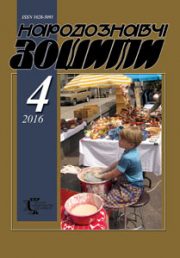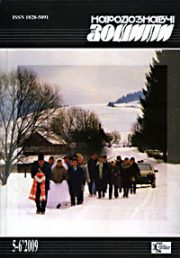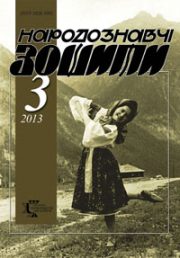The Ethnology Notebooks. 2021. № 4 (160), 900—908
UDK75.046:27-312.55]-043.86(477)”16/17″
DOI https://doi.org/10.15407/nz2021.04.900
LЕVYTSKA Mariana
- ОRCID ID: https://orcid.org/0000-0002-0977-4470
- PhD, Assistant professor,
- Senior Research Scholar,
- Department of Art History
- The Ethnology Institute of NASU,
- 15, Svobody Avenue, 79000, Lviv, Ukraine.
- Contacts: e-mail: m.levytska@gmail.com
LESIV Andriy
- ОRCID ID: https://orcid.org/0000-0002-3408-7496
- PhD, Senior Research Scholar
- Department of Art History
- The Ethnology Institute of NASU
- 15, Svobody Avenue, 79000, Lviv, Ukraine,
- Contacts: e-mail: lesiv@nas.gov.ua
Abstract. Problem statement. When studying causes and consequences of artistic transformations in Ukraine, one cannot avoid the issue of artistic influences (acquaintance, adaptation, rejection) in a wide temporal and territorial perspective. One of the aspects that well illustrates this broad field of art studies is the exploration of a certain narrow group of images is the cultural transfer theory, which is the paper’s methodological basis.
The purpose of the paper is to analyze the artistic evolution of the Apostles’ images in Ukrainian iconography in the 17th—18th centuries, considering the influences and citations from Western European painting and engravings. The research’s subject is the genesis and development of iconography’s style in Ukraine in the 17th—18th centuries, and the influence of Western European artistic traditions on it. The study focused on some of the most characteristic examples of the Apostles’ iconography, which can be regarded as an example of cultural transfer, in other words, the transfer of certain artistic schemes with their alteration according to the local requirements and expectations.
In particular, Jan Sadeler’s «the Last Supper» was considered as a model for several paintings in various variations, such as Pedro Ruiz De Salazar’s «the Last Supper» at the Cathedral of Santo Domingo de la Calzada in Spain in the mid-17th century, as well as for several the Last Supper icons in the Ukrainian icon painting of that period. Regarding the samples of the 18th c. Luka Dolynskyy’s life trajectory and artistic manner well represented the concept of cultural transfer. Most characteristic images of apostles painted by L. Dolynskyy for Uniate churches are compared with their West European prototypes, dated to the same period.
Results of the research. It was found that evolution of the new iconography and stylistics in sacral painting of the 17th—18th centuries were caused by patrons or clients, mainly the Church and local parishes, who endeavoured to «modernize» the tradition. Both patrons and painters have been interested in new iconographic samples, represented in Western ecclesiastic prints and engravings.
Keywords: cultural transfer theory, Ukrainian icon painting, images of apostles, illustrated Bibles, graphic samples.
Received 5.08.2021
REFERENCES
- Bialostocki, J. (1969). Rococo: ornament, style and attitude. Review of research issues. In: Rokoko. Studies of the art of the first half of 18th century; Proceedings of the Section of Art Historians. Warszawa [in Polish].
- Bialostocki, J. (1976). The Art of the Renaissance in Eastern Europe: Hungary — Bohemia — Poland. London.
- Da Costa Kaufmann, T. (2004). Toward a Geography of Art. Chicago et al.
- Da Costa Kaufmann, T. (2005). Paintered Enlightenment: The Art of Franz Anton Maulbertsch, 1724—1796. University of North Carolina Press.
- Burke, P., et al. (Eds.) (2007). Cultural Translation in Early Modern Europe. Cambridge.
- Cultural Transfer, by Wolfgang Schmale (Original in German, translated in English, published 2012—05—12). Retrieved from: http://ieg-ego.eu/en/threads/theories-and-methods/cultural-transfer (11-09-2018).
- Hock B., & Allas, A. (2018). Globalizing East European art Histories: Past and Present. Routledge.
- Schmale, W. (2012). Das 18. Jahrhundert. Vienna [in German].
- Skochylyas, I. (2010). Halych (Lviv) Eparchy in 12-18th centuries. Lviv [in Ukrainian].
- Svientsitska, V., & Sydor, O. (1990). The Heritage of centuries. Ukrainian painting of the 14-18th cc. in the Lviv’s museum collections. Lviv: Kameniar [in Ukrainian].
- Butler Jacobo Ollero. (1991). Some news about Flemish painting of the 16th century in Spain: Pieter de Witte and Denis Calvaert. Yearbook of the Department of History and Theory of Art (UAM) (Vol. III) [in Spanish].
- Holubets, M. (1924). Dolynskyy. Lviv [in Ukrainian].
- Kobryn, M. (2012). Zamoyskyy Synod and formation of the traditional identity of the Ukrainian Greek Catholic Church. Visnyk LNU (Issue 15) [in Ukrainian].
- Fenczak, A. (1995). Latinisation or Ockcydentalisation? On new directions of research on the role of Western influences in shaping the identity of the Greek Catholic Church in Poland in the years 1596—1772. In: Bulletin of the South-Eastern Scientific Institute in Przemysl, 1, 46—48 [in Polish].
- Stepovyk, D. (1982). Ukrayins’ka grafika XVI—XVIII stolit’. Evolutsiya obraznoyi systemy. Kyiv [in Ukrainian].
- Telesko, W. (2005). Einfuhrung in die Ikonographie der barocken Kunst. Wien u. a. [in German].
- Arijcuk, P., Hingelang, & Slavicek, L. (Eds.). (2007). F.A. Maulbertsch oder Caspar Franz Sambach. Franz Anton Maulbertsh und Mitteleuropa. Museum Lagenargen am Bodensee — SDU MU. Brno [in German].
- Levytska, M. (2011). Luka Dolynskyy’s Viennese experience (1775-1777 years). In: Notebooks of T.Schevchenko Scientific Society. Works of the commission of fine and applied art. (Vol. CCLXI) [in Ukrainian].
- Garas, K. (1968). Venetian painting of the 18th century. (Transl. from Hungarian). Budapest [in Russian].
- Lanckoronska, M., & Oehler R. (1923). Die Buchillustration des XVIII. Jahrhunderts in Deutschland, Osterreich und der Schweiz. Erster Teil: Die Buchillustration des Spatbarock und Rokoko. Leipzig [in German].
- (1995). The Illustrated Bartsch: Italian masters of the 16th—17th cc. (Vol. 39, part 2): Abaris Books: New York.
- Stoll P. The illustrated Bible of the brothers Joseph Sebastian and Johann Baptist Klauber.. Retrieved from:
- http://opus.bibliothek.uniaugsburg.de/opus4/files/565/Stoll_Klauber_Bilderbibel (14-08-2018)
- Lylyo, O. (1998). Posthumous description of the property of Ivan Phylypovych, Lviv engraver and printer of the 18th c. In: Notebooks of T.Schevchenko Scientific Society. Works of the commission of fine and applied art. (Vol. CCLXI), [in Ukrainian].
- Graphic from tape number 13 of the Fьrstlich Waldeckschen Hofbibliothek Arolsen Apostle portraits by Schelte a Bolswert after Gerard Seghers: S. Petrus. [in German]. Retrieved from: http://digi.ub.uni-heidelberg.de/fwhb/klebeband13 (21-08-2018) [in German].
- Vuytsyk, V. (2004). St.Onuphrius monastery in Lviv. In: Notebook of Instytut West Ukrainian Projects and Conservation. Lviv [in Ukrainian].







